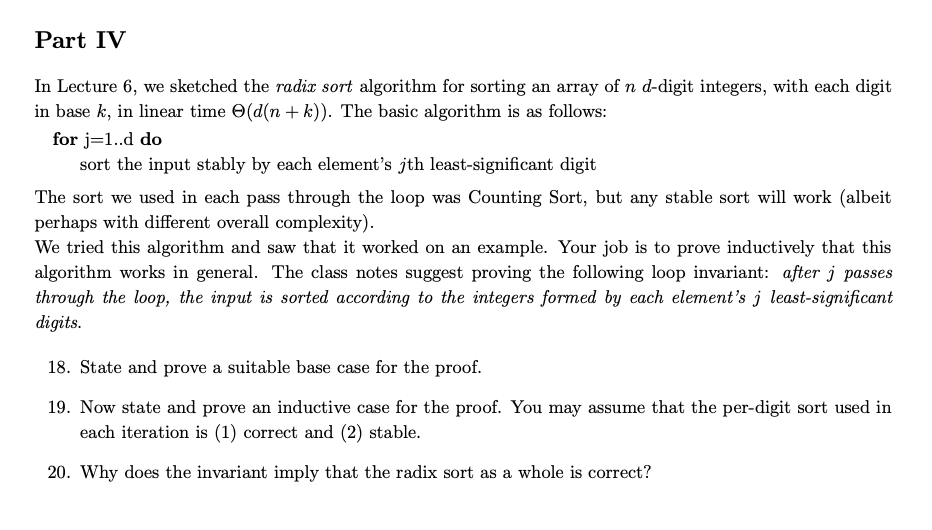Part IV In Lecture 6, we sketched the radix sort algorithm for sorting an array of n d-digit integers, with each digit in base k, in linear time (d(n + k)). The basic algorithm is as follows: for j=1..d do sort the input stably by each element's jth least-significant digit The sort we used in each pass through the loop was Counting Sort, but any stable sort will work (albeit perhaps with different overall complexity). We tried this algorithm and saw that it worked on an example. Your job is to prove inductively that this algorithm works in general. The class notes suggest proving the following loop invariant: after j passes through the loop, the input is sorted according to the integers formed by each element's j least-significant digits. 18. State and prove a suitable base case for the proof. 19. Now state and prove an inductive case for the proof. You may assume that the per-digit sort used in each iteration is (1) correct and (2) stable. 20. Why does the invariant imply that the radix sort as a whole is correct?
Part IV In Lecture 6, we sketched the radix sort algorithm for sorting an array of n d-digit integers, with each digit in base k, in linear time (d(n + k)). The basic algorithm is as follows: for j=1..d do sort the input stably by each element's jth least-significant digit The sort we used in each pass through the loop was Counting Sort, but any stable sort will work (albeit perhaps with different overall complexity). We tried this algorithm and saw that it worked on an example. Your job is to prove inductively that this algorithm works in general. The class notes suggest proving the following loop invariant: after j passes through the loop, the input is sorted according to the integers formed by each element's j least-significant digits. 18. State and prove a suitable base case for the proof. 19. Now state and prove an inductive case for the proof. You may assume that the per-digit sort used in each iteration is (1) correct and (2) stable. 20. Why does the invariant imply that the radix sort as a whole is correct?
Database System Concepts
7th Edition
ISBN:9780078022159
Author:Abraham Silberschatz Professor, Henry F. Korth, S. Sudarshan
Publisher:Abraham Silberschatz Professor, Henry F. Korth, S. Sudarshan
Chapter1: Introduction
Section: Chapter Questions
Problem 1PE
Related questions
Question
18, 19, 20

Transcribed Image Text:Part IV
In Lecture 6, we sketched the radix sort algorithm for sorting an array of n d-digit integers, with each digit
in base k, in linear time (d(n + k)). The basic algorithm is as follows:
for j=1..d do
sort the input stably by each element's jth least-significant digit
The sort we used in each pass through the loop was Counting Sort, but any stable sort will work (albeit
perhaps with different overall complexity).
We tried this algorithm and saw that it worked on an example. Your job is to prove inductively that this
algorithm works in general. The class notes suggest proving the following loop invariant: after j passes
through the loop, the input is sorted according to the integers formed by each element's j least-significant
digits.
18. State and prove a suitable base case for the proof.
19. Now state and prove an inductive case for the proof. You may assume that the per-digit sort used in
each iteration is (1) correct and (2) stable.
20. Why does the invariant imply that the radix sort as a whole is correct?
Expert Solution
This question has been solved!
Explore an expertly crafted, step-by-step solution for a thorough understanding of key concepts.
This is a popular solution!
Trending now
This is a popular solution!
Step by step
Solved in 3 steps

Knowledge Booster
Learn more about
Need a deep-dive on the concept behind this application? Look no further. Learn more about this topic, computer-science and related others by exploring similar questions and additional content below.Recommended textbooks for you

Database System Concepts
Computer Science
ISBN:
9780078022159
Author:
Abraham Silberschatz Professor, Henry F. Korth, S. Sudarshan
Publisher:
McGraw-Hill Education

Starting Out with Python (4th Edition)
Computer Science
ISBN:
9780134444321
Author:
Tony Gaddis
Publisher:
PEARSON

Digital Fundamentals (11th Edition)
Computer Science
ISBN:
9780132737968
Author:
Thomas L. Floyd
Publisher:
PEARSON

Database System Concepts
Computer Science
ISBN:
9780078022159
Author:
Abraham Silberschatz Professor, Henry F. Korth, S. Sudarshan
Publisher:
McGraw-Hill Education

Starting Out with Python (4th Edition)
Computer Science
ISBN:
9780134444321
Author:
Tony Gaddis
Publisher:
PEARSON

Digital Fundamentals (11th Edition)
Computer Science
ISBN:
9780132737968
Author:
Thomas L. Floyd
Publisher:
PEARSON

C How to Program (8th Edition)
Computer Science
ISBN:
9780133976892
Author:
Paul J. Deitel, Harvey Deitel
Publisher:
PEARSON

Database Systems: Design, Implementation, & Manag…
Computer Science
ISBN:
9781337627900
Author:
Carlos Coronel, Steven Morris
Publisher:
Cengage Learning

Programmable Logic Controllers
Computer Science
ISBN:
9780073373843
Author:
Frank D. Petruzella
Publisher:
McGraw-Hill Education